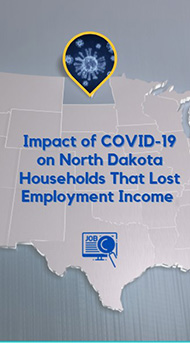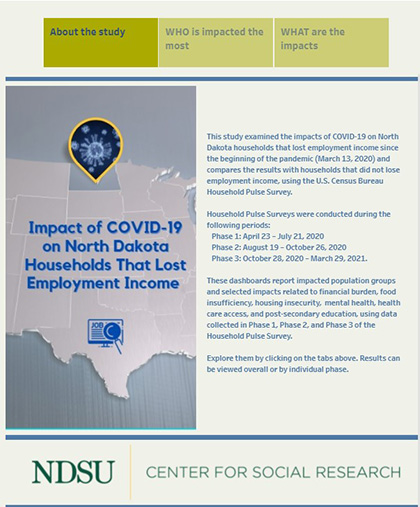Ask A Researcher
July 2021
COVID Hardship on North Dakota Households: New study on the impacts on North Dakota households that lost employment income during the pandemic
Kendra Erickson-Dockter is a research specialist with the Center for Social Research (CSR) at North Dakota State University (NDSU). Kendra has been with the Center since 2006 and served as project director of North Dakota Compass from 2013 - 2019. Currently, Kendra provides support for numerous CSR projects, such as North Dakota Compass and North Dakota Pregnancy Risk Assessment Monitoring System (PRAMS). Kendra received her master’s degree in Sociology and is a doctoral student in Human Development at NDSU. Ina Cernusca is the project director for North Dakota Compass and a research specialist within the CSR. With extensive experience in market and social research, she has participated in many projects that involved quantitative and qualitative research and outreach activities. Ina earned her MBA from the University of Missouri and worked as a marketing research specialist with the Center for Agroforestry at the University of Missouri prior to moving to North Dakota.
In this article, the authors highlight a new study and the new associated data dashboard developed by North Dakota Compass and the Center for Social Research at NDSU.
The Center for Social Research at North Dakota State University continues to develop new and reliable data resources to help North Dakota organizations and communities in their efforts to respond to the wide-range of challenges created by the COVID-19 pandemic. Similar to the previous analysis that explored the impacts of the pandemic on North Dakota households with children, the Center utilized the Household Pulse Survey microdata to examine impacts of the COVID-19 pandemic on North Dakota households that lost employment income. Selected results from the new study and dashboard are highlighted below.
WHO is impacted the most:
The health and economic crisis caused by the COVID-19 pandemic resulted in the loss of employment income for many people for a variety of reasons (e.g., illness with coronavirus, caring for ill family members, school and childcare closures, business closures, furlough, and layoffs).
- Two in five adults in North Dakota reported loss of employment income, for themselves or a household member, since the beginning of the pandemic (39%).
- While all population groups experienced loss of employment income, the hardest hit groups in North Dakota are the youngest adults, population of color, those with lower household income, and those with lower educational attainment.
Discover more data breakdowns on WHO is impacted!
WHAT are the impacts:
North Dakota households that lost employment income since the beginning of the pandemic were more likely to experience hardships such as financial burden, food insufficiency, housing insecurity, mental health issues, reduced access to health care, and negative impact on post-secondary education plans, than households that did not lose employment income.
- Financial Burden – North Dakota households that have experienced a loss of employment income since the beginning of the pandemic were more likely to struggle to pay for usual household expenses such as food, rent or mortgage, car payments, medical expenses, and student loans. One in two adults in households that lost employment income found it difficult (somewhat or very difficult) to pay for usual household expenses (47%) as compared to one in seven adults in households that did not lose employment income (14%).
- Food Insufficiency - North Dakota households that have experienced a loss of employment income since the beginning of the pandemic were more likely to experience food insufficiency than households that did not lose employment income. One in seven adults in households that lost employment income reported they did not have enough to eat - sometimes or often (15%) as compared to one in 25 adults in households that did not lose employment income (4%).
- Housing Insecurity - North Dakota households that have experienced a loss of employment income since the beginning of the pandemic were more likely to struggle to pay for usual household expenses such as rent or a mortgage. One in four adults in households that lost employment income and who own a house with a mortgage or pay rent were more likely to struggle in the ability to pay their next rent or mortgage payment on time - they had no or slight confidence in paying (25%) as compared to one in 14 adults in households that did not lose employment income (7%).
- Mental Health - The COVID-19 pandemic has negatively affected many people’s mental health and created new barriers for people already suffering from mental illness. The impact is greater for people that live in households that experienced financial hardship due to loss of employment. One in four adults in households that lost employment income felt down, depressed, or hopeless half of the days to nearly every day, in the past seven days (26%) as compared to one in eight adults in households that did not lose employment income (12%).
- Access to Medical Care - Reduced access to medical care is a serious consequence of the pandemic since delayed medical care can result in health complications and even death. In general, people may delay needed medical care due to cost. As a result of the pandemic however, people delayed getting medical care or were unable to get the care they needed due to cancelled appointments or procedures, reduced transportation options, fear of going to the hospital and risk of infection, or the desire to not be a burden on the health system. One in four adults in households that lost employment income did not get needed medical care - delayed or needed medical care and did not get the care because of the pandemic (24%) as compared to one in seven adults in households that did not lose employment income (14%).
- Post-secondary Education - The pandemic disrupted education plans for many people, especially for those with fewer resources or more responsibilities (e.g., caring for children, siblings, or elderly). One in three adults in households that lost employment income who planned to take post-secondary classes, cancelled all plans because of the pandemic (34%) as compared to one in five adults in households that did not lose employment income (21%).
Delve into more data breakdowns on the above impact topics!
The survey and analysis
The U.S. Census Bureau’s Household Pulse Survey measures the impact of COVID-19 on households across the U.S. from a social and economic perspective. This survey was designed to be as comprehensive as possible, administered quickly, and provide data in near real-time. While the data have some limitations due to online administration and lower response rates, benefits are notable since the survey produces near real-time data to help measure the impact of the COVID-19 pandemic on households. Data collection for the Household Pulse Survey began on April 23, 2020 and is conducted in phases: Phase 1 (April 23 – July 21, 2020), Phase 2 (August 19 – October 26, 2020), and Phase 3 (October 28, 2020 – March 29, 2021). The survey is currently collecting data in Phase 3.1. Survey data are released through an interactive data tool, tables, and microdata. The Household Pulse Survey Interactive Tool provides a visual representation of all the measures for the U.S., each of the 50 states and D.C., and for the 15 largest metropolitan statistical areas. Data tables in Excel for each week of release are available for download. In addition, microdata files are available to create custom tabulations and allow users to delve further into the rich data collected in the Household Pulse Survey.
Again, similar to the North Dakota household with children analysis, to visualize the results of the study on the impact of COVID-19 on households that lost employment income, North Dakota Compass is supplementing its usual data offerings and displaying the analyses with a series of dashboards. The NEW dashboard reports selected impacts of COVID-19 on North Dakota households related to household financial burdens, food insufficiency, housing insecurity, mental health, health care access, and post-secondary education based on data collected in Phase 1, Phase 2, and Phase 3. Results can be viewed overall or by each phase separately.


